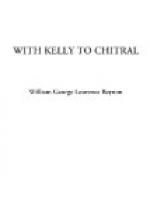“The baggage, under escort of the rearguard, remained in Gasht till ordered forward after the action.
“An advance was made to the river, where the bridge had been broken, but sufficiently repaired by the Sappers and Miners for the passage of the infantry. The guns forded the river, and the force ascended to the fan facing the right sangars of the enemy’s position.
“The configuration of the ground was as follows: The road from the river after leaving Gasht brought us on to an alluvial fan, the ascent to which was short and steep; it was covered with boulders and intersected with nullahs; the road led across this fan and then along the foot of steep shale slopes and shoots, within five hundred yards of the line of sangars crowning the opposite side of the river bank, and totally devoid of any sort or description of cover for some two miles; it could also be swept by avalanches of stones set in motion by a few men placed on the heights above for that purpose.
“The enemy’s position consisted of a line of sangars blocking the roads from the river up to the alluvial fan on which they were placed. The right of the position was protected by a snow glacier, which descended into the river bed, and furthermore by sangars, which extended into the snow line up the spur of the hills.
“The course of the action was as follows: The advanced guard formed up at about eight hundred yards from the position and the main body in rear. The 32nd Pioneers then advanced to the attack. One section, ‘C’ Company, extended (left of line). One section, ‘C’ Company, extended in support. Two sections, ‘C’ Company, ‘A’ Company, in reserve. The guns now took up position on the right and opened on ‘A’ sangar at a range of eight hundred and twenty-five yards. As the action progressed, the supporting section of ‘C’ Company advanced and reinforced. The remaining half of ‘C’ Company advanced, and, leaving sufficient space for the guns, took up their position in the firing line on the extreme right. Volley firing at first was opened at eight hundred yards, but the firing line advanced one hundred and fifty to two hundred yards as the action progressed. At a later stage, one section of ‘A’ Company was pushed up to fill a gap on the right of the guns in action in the centre of the line. The enemy, after receiving some well-directed volleys and correctly played shells, were seen to vacate ‘A’ sangar by twos and threes until it was finally emptied. During our advance to the fan, shots were heard in the direction of the hills, Lieutenant Beynon having come into contact with the enemy in their sangars up the hillside, who were driven from ridge to ridge. When ‘A’ sangar was vacated, attention was directed on ‘B’ sangar, and the same course adopted, with the same result; at the same time those driven down from the hills above streamed into the plain, and there was then a general flight. Six shrapnel were fired into the flying enemy at ranges of a thousand, twelve hundred, and thirteen hundred and fifty yards (three rounds per gun).




